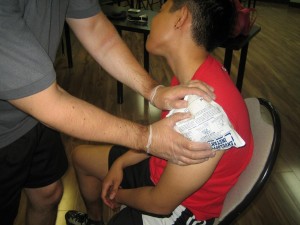A rotator cuff tear involves damage to the 4 rotator cuff muscles within the shoulder. This injury is quite common in racket and throwing sports. These muscles are responsible for rotating the arm as well as serve as a cuff that provides support around the joint. The injury can vary from minor to severe.
The treatment is aimed on minimizing the pain and inflammation and followed by a rehabilitation program that includes strengthening, mobility and sports-specific exercises.
What are the indications?
The indications of a torn rotator cuff include the following:
- Abrupt shoulder pain that can be accompanied by a tearing sensation
- The discomfort or pain might radiate down the arm
- Difficulty sleeping on the affected shoulder
- Indications of shoulder impingement might be present in which the tendon pinches between the ball and socket of the shoulder joint when the arm is moved out over the head.
- Pain steadily worsens over time
Abrupt shoulder pain that can be accompanied by a tearing sensation. - Weakness in the shoulder up to a point where the individual could not lift his/her arm up to the side
- Overhead movements can be difficult
Usual causes of a rotator cuff tear
A rotator cuff tear is typically caused by overstretching or abrupt twisting of the joint. Due to the wide range of motion of the shoulder joint and often used at high speeds in throwing sports, the risk for injury is higher especially to the tendons or muscles.
In sports that involves constant shoulder rotation such as in baseball, cricket, kayaking and swimming, the supraspinatus and infraspinatus are the commonly damaged rotator cuff muscles. The injury is also prevalent among older individuals especially if there is long-term overuse or deterioration.
In throwing activities, the root of the injury is brought about by rapid deceleration or stopping of the arm after a throw is released.
Management
The treatment for this injury is aimed on minimizing the initial discomfort and inflammation, healing of the tissues and starting a rehabilitation program that involves stretching, mobilization and strengthening of the shoulder.
Initial care
The initial care for a rotator cuff tear is adequate rest and the PRICE method (protection, rest, ice, compression, elevation).
Apply an ice pack to reduce the swelling and pain. The earlier the ice pack is applied, the sooner the inflammation, swelling and pain stops. It also promotes early healing of the injury. The application should last for 10 minutes every hour and reduced to 3-4 times throughout the day as the pain settles.
It is vital to allow the affected arm to rest. This is done using a sling for severe cases if there is a need to go to work or school to immobilize the shoulder but can be removed at night. Once the acute phase has passed, mobility and strengthening exercises can be started if pain is not triggered.
In case the injury is more than a few days old and becomes chronic, alternating heat and ice might be beneficial. During the late phases of rehabilitation, heat is usually advised.
More Information / Disclaimer
The information posted on this page on a rotator cuff tear is for learning purposes only. Learn to recognize and manage shoulder joint and muscle injuries by taking a standard first aid course with Ottawa First Aid.

